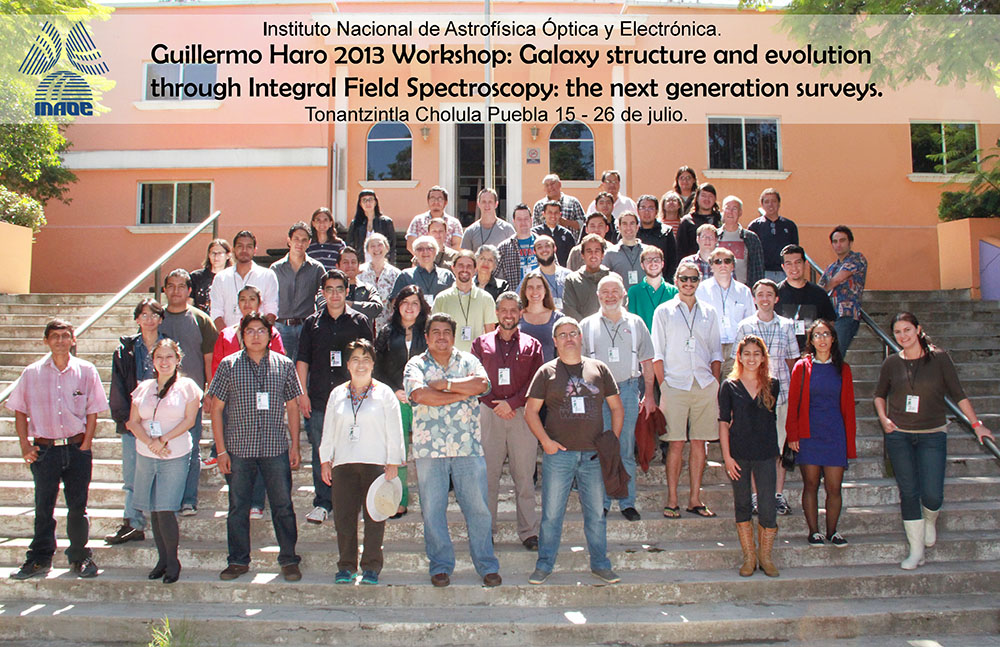
July 15-26, 2013, Tonantzintla, Puebla, Mexico

Workshop photo album
We are glad to announce the 15th addition of the Guillermo Haro Workshop in Advanced Astrophysical Research.
Mission and visionThe workshop will bring together leading experts in the field at a very special moment, when the first batch of results from the leading large scale IFS-surveys are coming out. Scientists involved in the surveys ATLAS3D, CALIFA, MaNGA, SAMI and VENGA will present and discuss their hot off-the-oven results. More importantly, they will brainstorm and exchange ideas on the numerous observational, computational and theoretical challenges posed by the new approaches enabled by 3D spectroscopy of thousand-sized large samples. The workshop will serve to create awareness in the international community by means of fostering a synergy between these large ongoing collaborations, in order to develop new methods of analysis and visualization for the massive multidimensional data sets already arriving, and to contrast the two complementary approaches to galaxy evolution: fossil record versus lookback time studies. These IFS surveys will play a major role in shaping galaxy-related research in the next decade. Their impact is bound to be similar to that of the SDSS, but with the possibility to focus on the inner workings of galaxies and their complex structures. The workshop will be the first opportunity for all the teams to gather in a truly collaborative working environment. We thus expect the workshop to promote significant scientific advances and to foster collaborations.
Context and motivation
Last decade technology has lead to massive surveys either in imaging or spectroscopy modes which have fostered significant insight on the integrated properties of galaxies, as well as on their mass assembly history and the star formation history (SFH) of the universe. However, these surveys are limited in either spectral or spatial resolution. Broad band imaging provides spatial information, but at the expense of coarse spectral coverage, limiting the amount of information on the stellar populations, and providing little or no information on emission lines nor the kinematics of galaxies. Spectroscopic surveys offer a much richer list of diagnostics of the gaseous and stellar components, but lack spatial resolution and suffer from severe aperture effects (one spectrum per object, but not covering the full galaxy). Moreover, integrated galaxy spectra do not allow to, for example, isolate morphological components (bulge, disc, bars), map the effects of mergers, trace secular processes such as stellar migration, and other features of galaxy formation and evolution which can only be observationally tackled with a combination of imaging and spectroscopic capabilities. This context explains the proliferation of Integral Field Spectroscopy (IFS) surveys such as ATLAS3D (Cappellari et al. 2011), CALIFA (Sánchez et al 2012), SAMI (Croom et al 2012), MaNGA (Bundy et al, in prep.) and VENGA (Blanc et al 2009). An alternative approach to the same overall issue is to carry out imaging surveys in narrow-band/tunable filters. The loss of spectroscopic detail in this case is compensated by the ability to survey many more objects and to cover fields wider than those accessible by current IFUs. These pioneer IFS projects will allow a detailed look at physics within galaxies, as opposed to the global view offered by integrated light surveys. They represent a true shift in observational paradigm, where the 2D images and 1D spectra are replaced by 3D datacubes. Exploring this new and promising world requires both the combination of traditional imaging and spectroscopy data-analysis techniques (like bulge/disk decomposition and spectral synthesis of stellar populations by means of fossil-record methods) and the development of new tailor-made methods. There are numerous challenges involved, ranging from technical (data acquisition and calibration/reduction) and computational issues (data structuring, metadata organization, visualization techniques) to ways to analyse the stellar and gaseous information contained in the observational datacubes and transform it to physical hypercubes like the mass in stars of a given age and metallicity as a function of position x,y. Last but not less important, theoreticians must be summoned to adapt their predictions to the constraints imposed by the observations and to aid in the interpretation of the results obtained and in devising realistic datacube-oriented diagnostics of important physical processes. Models of galaxy formation and evolution are currently limited by the lack of spatial resolution to adequately track all relevant phenomena (the “sub-grid physics” issue), so this synergy between theory and observations is bound to lead to substantial progress in our theoretical understanding as well. The workshop will bring together the leading groups in this blooming and exciting field, which will be at the forefront of extragalactic research for the next decade. Critically, the workshop will happen right at the moment when the main observational projects will be bearing their first fruits, an ideal moment to share, compare and explore ideas.